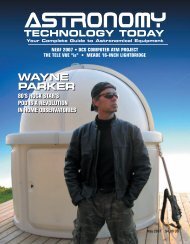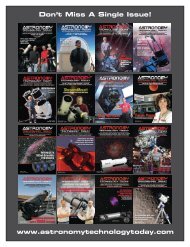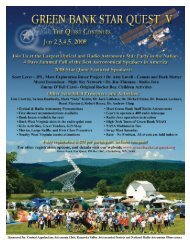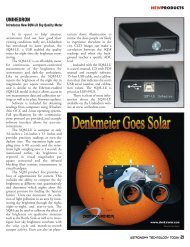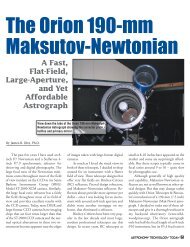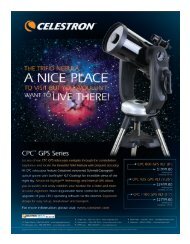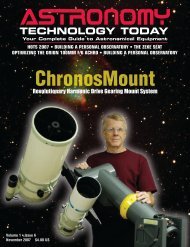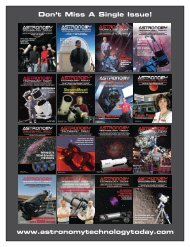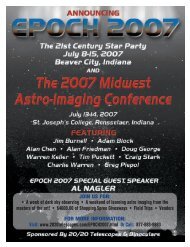iOPTRON - Astronomy Technology Today
iOPTRON - Astronomy Technology Today
iOPTRON - Astronomy Technology Today
Create successful ePaper yourself
Turn your PDF publications into a flip-book with our unique Google optimized e-Paper software.
M-UNO: A PIER-LESS MOUNT<br />
Image 7 - NGC 2903 in Leo. Image 6 cropped and enlarged to<br />
400 percent over original.<br />
Image 6 - NGC 2903 in Leo. Full frame, 30 minutes. (L only). Boxed area<br />
cropped and enlarged 400 percent and shown in Image 7.<br />
riodic error by recording the drift and compensating<br />
for it with the mount’s electronera<br />
on an Orion off-axis guider. Having no<br />
1000 DSLR and a Lodestar guiding camics.<br />
Autoguiding programs can also experience with DSLR cameras, I was anxious<br />
to use my SBIG ST-8XME camera<br />
compensate for periodic error.<br />
Virtually everyone wants to know and CFW10 filter wheel to see how well<br />
what the M-Uno's periodic error is. That the mount performed. On a clear night at<br />
question does not really apply to this WSP 2013, Luciano afforded me the op-<br />
mount since the M-Uno does not use<br />
worm gears and the multiple belts and pulleys<br />
do not generate that anomaly as commonly<br />
perceived and understood. Each of<br />
the four pulleys, by themselves, would generate<br />
a periodic error. However, all four<br />
pulleys combined average out the periodic<br />
error of each one. If plotted on a graph, the<br />
curve spreads out over a far longer time<br />
span than that of a standard worm-andwheel<br />
gear. It is more descriptive to compare<br />
the M-Uno’s tracking error rate to that<br />
of other worm-and-wheel driven mounts.<br />
The M-Uno I evaluated rides atop the<br />
Avalon Hercules tripod. Constructed of<br />
beautifully varnished hardwood, the tripod<br />
has an anodized aluminum base and a<br />
brass pier for adjusting the M-Uno’s azimuth<br />
setting during polar alignment. An<br />
accessory tray provides stability for the legs.<br />
Each leg has a reversible, adjustable red anodized<br />
aluminum foot. One end is for use<br />
on grass and the other end has a rubber<br />
foot for use on hard surfaces.<br />
Luciano brought with him to WSP an<br />
imaging f/6 Intes 110 Mak-Cass, a Canon<br />
portunity to run the M-Uno using his Intes<br />
OTA and my camera and filter wheel. The<br />
astronomical images included in this article<br />
were taken with this configuration. I controlled<br />
my camera from my laptop running<br />
MaximDL, and ran the mount from Luciano’s<br />
laptop using the StarGo control soft-<br />
<strong>Astronomy</strong> TECHNOLOGY TODAY 47



